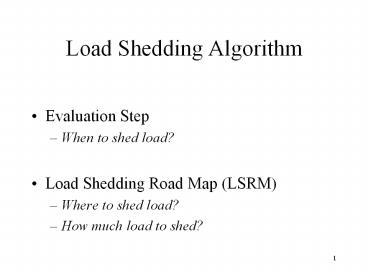Load Shedding Algorithm - PowerPoint PPT Presentation
Title:
Load Shedding Algorithm
Description:
Load Shedding Algorithm Evaluation Step When to shed load? Load Shedding Road Map (LSRM) Where to shed load? How much load to shed? Load Evaluation Load Coefficients ... – PowerPoint PPT presentation
Number of Views:1993
Avg rating:3.0/5.0
Title: Load Shedding Algorithm
1
Load Shedding Algorithm
- Evaluation Step
- When to shed load?
- Load Shedding Road Map (LSRM)
- Where to shed load?
- How much load to shed?
2
Load Evaluation
- Load Coefficients (L)
- the number of processor cycles required to push a
single tuple through the network to the outputs
- n operators
- ci cost
- si selectivity
3
Load Evaluation Load Coefficient
L1 10 (0.5 10) (0.5 0.8 5) (0.5
10) 22 L2 10 (0.8 5) 14
4
Load Evaluation
- Stream Load (S)
- load created by the current stream rates
- m input streams
- Li load coefficient
- ri input rate
5
Load EvaluationStream Load
S 22 10 220
6
Load Evaluation
- Queue Load (Q)
- load due to any queues that may have built up
since the last load evaluation step - MELT_RATE how fast to shrink the queues
- (queue length reduction per unit
time)
- Li load coefficient
- qi queue length
Q MELT_RATE Li qi
7
Load EvaluationQueue Load
MELT_RATE 0.1 Q 0.1 5 100 50
8
Load EvaluationTotal Load
- Total Load (T) S Q
T 220 50 270
9
Load Evaluation
- The system is overloaded when
10
Load Shedding Algorithm
- Evaluation Step
- When to drop?
- Load Shedding Road Map (LSRM)
- How much to drop?
- Where to drop?
11
Load Shedding Road Map (LSRM)
12
LSRM Construction
13
Drop Locations
Single Query
14
Drop Locations
Single Query
15
Drop Locations
Shared Query
16
Drop Locations
Shared Query
17
Loss/Gain RatioLoss
- Loss utility loss as tuples are dropped
- determined using loss-tolerance QoS
graph
Loss for first piece of graph (1 0.7) / 50
0.006
18
Loss/Gain RatioGain
- Gain processor cycles gained
- R input rate into drop operator
- L load coefficient
- x drop percentage
- D cost of drop operator
- STEP_SIZE increments for x to find G(x)
19
Drop-Based Load Sheddinghow much to drop?
- Take the least Loss/Gain ratio
- Determine the drop percentage p
20
Drop-Based Load Sheddingwhere to drop?
If there are other drops in the network, modify
their drop percentages.
21
Drop-Based Load Sheddingmake LSRM entry
- All drop operators with the modified percentages
form the DIP - Compute CSC
- Advance QoS cursors and store in PDC
LSRM Entry ltCycle Savings Coefficients (CSC)
Drop Insertion Plan (DIP) Percent Delivery
Cursors (PDC)gt
22
Filter-Based Load Sheddinghow much to
drop?predicate for filter
- Start dropping from the interval
- with the lowest utility.
- Keep a sorted list of intervals according to
their utility and relative frequency. - Find out how much to drop and what intervals are
needed to . - Determine the predicate for filter.
23
Filter-Based Load Sheddingplace the filter
If there are other filters in the network, modify
their selectivities.































